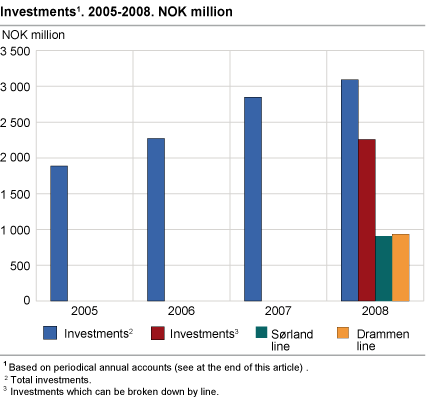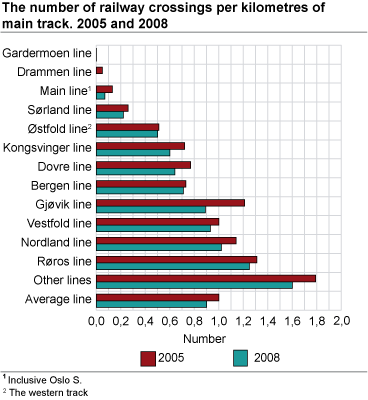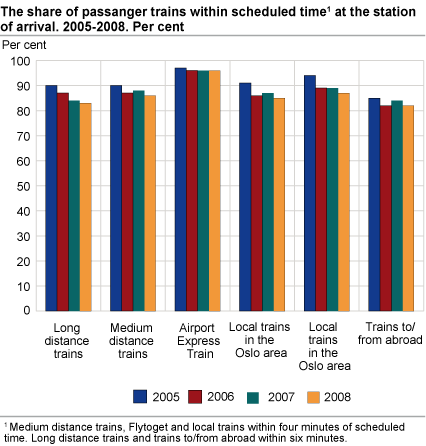Content
Published:
This is an archived release.
Slower growth in the investments
Government investment in the rail network came to almost NOK 3.1million in 2008; an increase from 2007 of NOK 245 million, or 9 per cent.
Though this was a considerable growth, the growth in investments was lower compared to the two previous years, with an increase in investments of NOK 480 million per year on average. Almost 2 900 man-years were carried out in governmental activity in administrating the railway infrastructure, operational management of trains and assigning routes.
16 per cent increase in assets
Governmental assets in the public-owned rail network, showed an accounting value of NOK 29.1 billion in 2008. This was an increase of NOK 4 billion, or 16 per cent, compared to 2007. However, the Norwegian National Rail Administration has performed a more complete estimation of their assets. The considerable increase in investments in 2008 compared to 2007 must be viewed against this background.
More than 130 tracks for crossing longer than 600 metres
The small share of double tracks (5.5 per cent) is a challenge for better utilisation of the railway track, especially for the transport of goods by rail. Building new tracks for crossing and extension of the old ones are among the capacity promotive actions the Government has pursued. In 2008, there were 330 tracks for crossing in total. Of these, 133 were longer than 600 metres.
Fewer railway crossings but increased number of crossings with barriers, lights and klaxons
About 3 700 level crossings were registered in 2008; a decrease of 425 from 2005 and 75 fewer compared to 2007. The number of crossings with barriers, lights and klaxons increased with 25 crossings, or 7 per cent, from 2007 to 2008. The share of crossings with barriers, lights and klaxons comprised 10.2 per cent in 2008.
Poor punctuality
Punctuality fell from 2005 to 2007 and further in 2008 with the exception of the Flytoget (airport express), with the highest punctuality in recent years of about 95 per cent. Of all railways, the long distance trains and the trains leaving/entering the Norwegian border were the types of train with the poorest punctuality in 2008: 83 and 82 per cent respectively.
Few people are hurt...
Railway transport is a secure mode of transport. Only one person was killed and one was injured in connection with such accidents in 2008.
...but lots of animals suffer
Nearly 1 900 animals were hit and killed by a train in 2008. This was almost the same number of animals killed as in 2007, but compared to 2005 the increase was 45 per cent. Elks are involved in half of these accidents.
Public railway operationRailway infrastructure administratorUntil 1996, both the administration of the railway infrastructure and train transport were placed under the public management company Norwegian State Railways. This company was subsequently split in two: The administrative body Norwegian National Rail Administration and the public-owned company Norwegian State Railways plc (which changed to a private limited company as of July 2002). Norwegian National Rail Administration is responsible for administering the railway infrastructure, the operational management of trains and assigning routes. The enterprise was included in StatRes in 2008. AllocationsThe activity of the Norwegian National Rail Administration is entirely based on governmental allocations. Periodical annual accountsNorwegian National Rail Administration is involved in a pilot project to develop periodical annual accounts for public enterprises. The project is managed by the Ministry of Finance. The Norwegian National Rail Administration has kept accounts since 2005 based on the preliminary standards developed for these types of accounts (in addition to keeping the normal cash flow accounting). The figures referred to in this article are in accordance with the periodical annual accounts. In cash flow accounting, the expenditures and earnings are reported on the settlement date, while in periodic accounts, the expenditures are charged when they are incurred and the revenues when they are earned. The governmental activity within administrating the railway infrastructure, the operational management of trains and assigning routes forms part of StatRes - State resource use and results. The purpose of StatRes is to show the level of resources that the state uses, what this input provides in terms of activities and services in the various government activities, and what outcomes can be seen from the input. Its aim is to provide the general public and the authorities with more knowledge of state-run activities. |
Find more figures
Also find statistics about the quality of the track, number of stations, platforms, tunnels and bridges.
Additional information
The statistics give an overview of the amount of resources the Norwegian National Rail Administration spends on administrating the infrastructure, the operational management of trains and assigning routes, and the results of the effort.
Contact
-
Statistics Norway's Information Centre
E-mail: informasjon@ssb.no
tel.: (+47) 21 09 46 42



